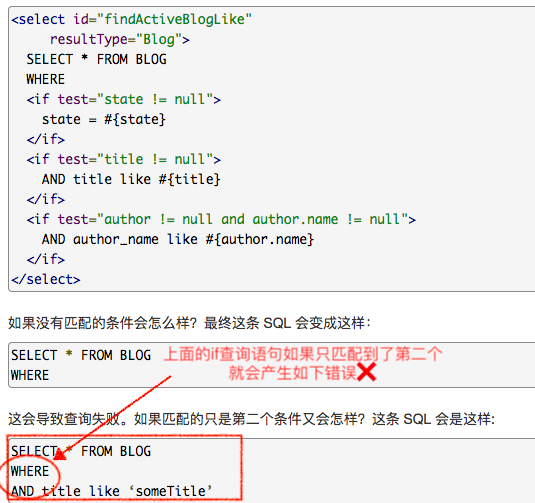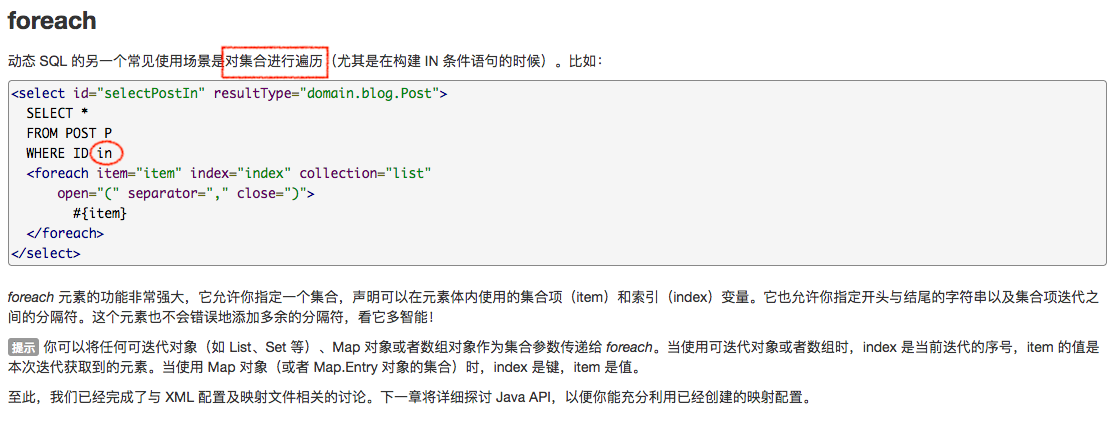动态SQL详解
什么是动态SQL:动态SQL就是指根据不同的条件生成不同的SQL语句
1 2 3 4 5 如果你之前用过 JSTL 或任何基于类 XML 语言的文本处理器,你对动态 SQL 元素可能会感觉似曾相识。在 MyBatis 之前的版本中,需要花时间了解大量的元素。借助功能强大的基于 OGNL 的表达式,MyBatis 3 替换了之前的大部分元素,大大精简了元素种类,现在要学习的元素种类比原来的一半还要少。 if choose (when, otherwise) trim (where, set) foreach
所谓的动态SQL本质上还是SQL语句,只是我们可以在SQL层面上,去执行逻辑代码。
一、环境搭建
1. 创建blog表
1 2 3 4 5 6 7 CREATE TABLE `blog`(`id` VARCHAR (50 ) NOT NULL COMMENT '博客id' , `title` VARCHAR (100 ) NOT NULL COMMENT '博客标题' , `author` VARCHAR (30 ) NOT NULL COMMENT '博客作者' , `create_time` DATETIME NOT NULL COMMENT '创建时间' , `views` INT (30 ) NOT NULL COMMENT '浏览量' )ENGINE= INNODB DEFAULT CHARSET= utf8
2. 新建Blog实体类
1 2 3 4 5 6 7 8 9 @Data @NoArgsConstructor public class Blog private int id; private String title; private String author; private Date create_time; private int views; }
3. 新建BlogMapper接口
1 2 3 4 package com.nichu.dao;public interface BlogMapper }
4. 编写Blog.xml
1 2 3 4 5 6 7 <?xml version="1.0" encoding="UTF-8" ?> <!DOCTYPE mapper PUBLIC "-//mybatis.org//DTD Config 3.0//EN" "http://mybatis.org/dtd/mybatis-3-mapper.dtd" > <mapper namespace ="com.nichu.dao.BlogMapper" > </mapper >
5. 在核心配置文件中绑定接口
1 2 3 4 <mappers > <mapper class ="com.nichu.dao.BlogMapper" /> </mappers >
6. 编写IDutils工具类用于生成UUID
1 2 3 4 5 6 7 import java.util.UUID;public class IDutils public static String getId () return UUID.randomUUID().toString().replaceAll("-" ,"" ); } }
7. 开启驼峰命名自动转换
在核心配置文件中配置
1 2 3 4 5 6 7 <settings > <setting name ="logImpl" value ="STDOUT_LOGGING" /> <setting name ="mapUnderscoreToCamelCase " value ="true" /> </settings >
编写测试类并插入数据
1 2 3 4 5 6 7 8 9 10 11 12 13 14 15 16 17 18 19 20 21 22 23 24 25 26 public void addBlogTest () SqlSession sqlSession = MybatisUtils.getSqlSession(); BlogMapper mapper = sqlSession.getMapper(BlogMapper.class); Blog blog = new Blog(); blog.setId(IDutils.getId()); blog.setTitle("Mybatis" ); blog.setAuthor("狂神说" ); blog.setCreateTime(new Date()); blog.setViews(9999 ); mapper.addBook(blog); blog.setId(IDutils.getId()); blog.setTitle("Java" ); mapper.addBook(blog); blog.setId(IDutils.getId()); blog.setTitle("Spring" ); mapper.addBook(blog); blog.setId(IDutils.getId()); blog.setTitle("微服务" ); mapper.addBook(blog); sqlSession.close(); }
二、if
1 2 3 4 5 6 7 8 9 10 11 <select id ="queryBlogIF" parameterType ="Map" resultType ="com.nichu.pojo.Blog" > select * from mybatis.blog where 1=1 <if test ="title!=null" > and title = #{title} </if > <if test ="author!=null" > and author = #{author} </if > </select >
1 2 3 4 5 6 7 8 9 10 11 12 public void addBlogTest () SqlSession sqlSession = MybatisUtils.getSqlSession(); BlogMapper mapper = sqlSession.getMapper(BlogMapper.class); Map map = new HashMap(); map.put("author" ,"狂神说" ); List<Blog> blogs = mapper.queryBlogIF(map); for (Blog blog : blogs) { System.out.println(blog); } sqlSession.close(); }
三、 choose (when, otherwise)
用法相当于java中的switch (case default)
chose --> switch
执行时只要满足其中一个条件就结束
1 2 3 4 5 6 7 8 9 10 11 12 13 14 15 16 <select id ="queryBlogChoose" parameterType ="Map" resultType ="com.nichu.pojo.Blog" > select * from mybatis.blog <where > <choose > <when test ="title != null" > and title = #{title} </when > <when test ="author != null" > and author = #{author} </when > <otherwise > and views = #{views} </otherwise > </choose > </where > </select >
四、 trim (where, set)
因此只要将查询语句中的where部分用 <where > 标签包裹即可
<set>标签的意义和<where>标签一样,每设置一个属性,都要在语句后加 “,” 由于不知道哪个语句结尾,所有要用<set>标签自动处理。
1 2 3 4 5 6 7 8 9 10 11 12 <update id ="updateBlog" parameterType ="map" > update mybatis.blog <set > <if test ="title!=null" > title = #{title}, </if > <if test ="author!=null" > author = #{author}, </if > </set > where id = #{id} </update >
<trim>可以自定义<where>标签和<set>标签
where 元素只会在子元素返回任何内容的情况下才插入 “WHERE” 子句。而且,若子句的开头为 “AND” 或 “OR”,where 元素也会将它们去除。
如果 where 元素与你期望的不太一样,你也可以通过自定义 trim 元素来定制 where 元素的功能。比如,和 where 元素等价的自定义 trim 元素为:
1 2 3 <trim prefix ="WHERE" prefixOverrides ="AND |OR " > ... </trim >
set 元素会动态地在行首插入 SET 关键字,并会删掉额外的逗号(这些逗号是在使用条件语句给列赋值时引入的)。
以下是set 元素等价的自定义trim
1 2 3 <trim prefix ="SET" suffixOverrides ="," > ... </trim >
五、SQL片段
有时候,我们可能会将一些功能的部分抽取出来,方便复用!
使用SQL标签抽取公共的部分
1 2 3 4 5 6 7 8 <sql id ="if-title-author" > <if test ="title!=null" > and title = #{title} </if > <if test ="author!=null" > and author = #{author} </if > </sql >
在需要使用的地方使用Include标签引用即可
1 2 3 4 5 6 7 <select id ="queryBlogIF" parameterType ="Map" resultType ="com.nichu.pojo.Blog" > select * from mybatis.blog <where > <include refid ="if-title-author" > </include > </where > </select >
注意事项
最好基于单表来定义SQL片段!
不要存在where标签
六、<foreach>标签
1. 查询id为(1-2-3)的博客记录
SQL语句:
1 2 select * from mybatis.blog where id in (1 ,2 ,3 )select * from mybatis.blog where (id= 1 or id= 2 or id= 3 )
2. 使用foreach遍历id
1 2 3 4 5 6 7 8 <select id ="queryBlogForEach" parameterType ="map" resultType ="com.nichu.pojo.Blog" > select * from mybatis.blog <where > <foreach collection ="ids" open ="and (" close =")" separator ="or" item ="id" > id=#{id} </foreach > </where > </select >
3. 编写测试类
1 2 3 4 5 6 7 8 9 10 11 12 13 14 15 16 17 public void addBlogTest () SqlSession sqlSession = MybatisUtils.getSqlSession(); BlogMapper mapper = sqlSession.getMapper(BlogMapper.class); Map map = new HashMap(); ArrayList<Integer> ids = new ArrayList<>(); ids.add(1 ); ids.add(2 ); ids.add(4 ); map.put("ids" ,ids); List<Blog> blogs = mapper.queryBlogForEach(map); for (Blog blog : blogs) { System.out.println(blog); } sqlSession.close(); }
关于动态SQL的一些建议
先在MySQL中写出完整的SQL语句,再对应的去修改成为动态SQL实现通用即可。



